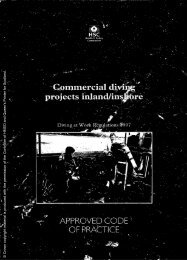HSG123: Working together on firework displays - Health and Safety ...
HSG123: Working together on firework displays - Health and Safety ...
HSG123: Working together on firework displays - Health and Safety ...
You also want an ePaper? Increase the reach of your titles
YUMPU automatically turns print PDFs into web optimized ePapers that Google loves.
Selecting a site for the display<br />
<strong>Health</strong> <strong>and</strong> <strong>Safety</strong><br />
Executive<br />
Definiti<strong>on</strong>s used in the text <strong>and</strong> in Figure 1<br />
16 The display site is the whole site used for the display, <strong>and</strong> is made up of:<br />
n the spectator area – from which the spectators watch the display;<br />
n the safety area – a clear area between the spectators <strong>and</strong> the firing area to<br />
ensure that spectators are at a safe distance from the <strong>firework</strong>s during the<br />
display;<br />
n the firing area – from which the <strong>firework</strong>s are set off;<br />
n the fall-out area (or dropping z<strong>on</strong>e) – an area kept clear of people, where the<br />
debris from spent aerial <strong>firework</strong>s l<strong>and</strong>s; <strong>and</strong><br />
n the b<strong>on</strong>fire area – the area provided for the b<strong>on</strong>fire (if there is to be <strong>on</strong>e).<br />
17 Figure 1 shows how these areas should be located in relati<strong>on</strong> to each other<br />
<strong>and</strong> the prevailing wind directi<strong>on</strong>.<br />
18 The display site needs to be large enough to ensure all the above areas can<br />
cope with:<br />
n the types of <strong>firework</strong>s to be used (this affects the size of the safety area <strong>and</strong> the<br />
fall-out area);<br />
n a change in the directi<strong>on</strong> or strength of the wind;<br />
n the expected number of spectators.<br />
19 The table in Figure 1 gives guidance <strong>on</strong> minimum dimensi<strong>on</strong>s. The safety<br />
distances given will be adequate in many cases, but the display operator may<br />
require greater distances for certain sizes or types of <strong>firework</strong>s, for example crown<br />
wheels or flying saucers, or the larger sizes of shells. Allowance should be made for<br />
the burst diameter of shells when assessing safety distances. A 125 mm shell, for<br />
example, can project effects further than 50 metres <strong>and</strong> could therefore endanger<br />
spectators if it malfuncti<strong>on</strong>ed at ground level without sufficiently extended safety<br />
distances.<br />
20 In special circumstances the safety distances given in the table may not always<br />
be appropriate, for example where <strong>displays</strong> are to be fired from unusual sites such<br />
as a barge <strong>on</strong> a river, the roof of a building, a bridge, or where <strong>on</strong>ly lancework or<br />
certain other n<strong>on</strong>-aerial <strong>firework</strong>s are to be used. In these cases it will be necessary<br />
for the operator to carefully assess the risks <strong>and</strong> decide <strong>on</strong> suitable spectator<br />
areas.<br />
21 If you are using steel mortar tubes you should take account of hard surfaces<br />
such as car parks, buildings <strong>and</strong> bridges near the firing site which could cause the<br />
ricochet of steel fragments if mortar tubes fail. Ricochets can increase the distance<br />
travelled by fragments by as much as 30%.<br />
22 Ensure the site is free of dry, cut grass <strong>and</strong> other readily combustible materials.<br />
<str<strong>on</strong>g>Working</str<strong>on</strong>g> <str<strong>on</strong>g>together</str<strong>on</strong>g> <strong>on</strong> <strong>firework</strong> <strong>displays</strong> Page 9 of 32







